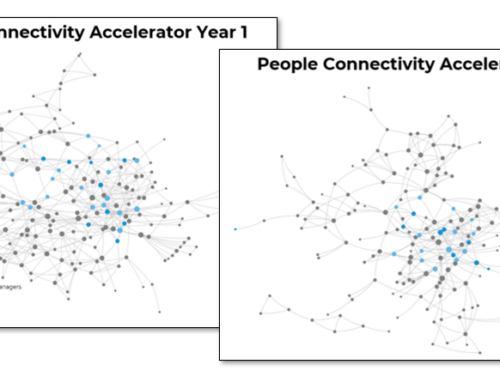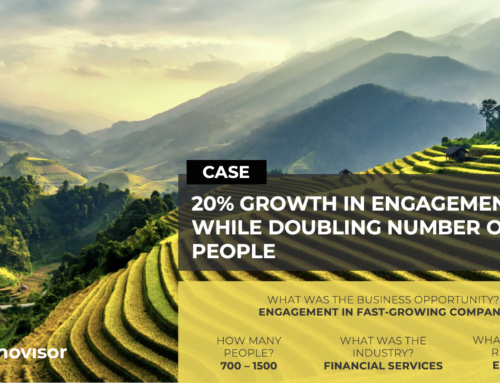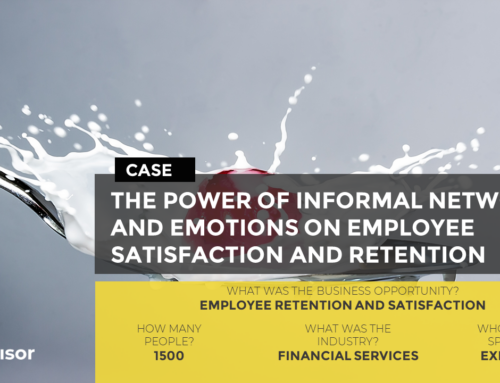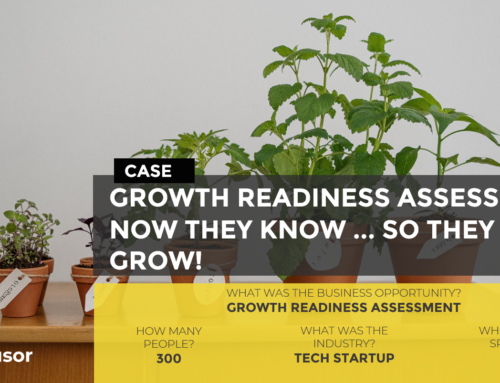How to strengthen employee engagement while navigating through major transformation? Read the journey of a European conglomerate.
EMPLOYEE ENGAGEMENT – FROM TOUGH FEEDBACK TO TARGETED ACTION
One of our clients is a European conglomerate. All the different parts of this conglomerate are on the same journey: to strengthen their employee engagement so that it can navigate through major changes. Twice a year, they ask their employees for feedback to ensure the company responds with appropriate actions.
This article shows how this journey goes for one of its parts with 500 employees. Within two years, the tough feedback from the employees moved from being only in a couple of parts of the organization to the whole of the organization. Leadership needed to act quickly with targeted actions:
- to sustain an environment of integrity, trust, and respect by immediate managers
- to suit the actions to senior management’s words
CHALLENGE 1: Poor engagement in times of Transformation
In the first 12 months, it was business as usual. No major changes occurred, and – overall – people were happy to be with the company. Major changes happened from after 12 months and onwards.
From this time, the company actively restructured itself. It needed to transform itself into a truly digital business. This restructuring resulted in the appointment of new top executives, the lay-off of employees, and the acquisition of a new product portfolio. These developments made the people anxious and the state-of-engagement decreased significantly.

Figure 1 – Would you recommend our company as a great workplace? This figure shows the percentage of people who are most happy (the promoters), who are indecisive (the passives), and who are least happy (the detractors).
Figure 1 shows how the degree of engagement dropped overtime. The group of detractors almost doubled in size in two years. Nearly half of the workforce – 46% to be exact – indicated that they would not recommend the company as a great workplace to a friend. Only 19% of the workforce would recommend the company.
Challenge 2: Poor engagement across the business
In the past 24 months, the average number of years people worked for the company – known as tenure – was stable. It moved between 7,5 and 8,3 years. In the past 18 months, the tenure of the group of detractors was also stable moving between 10 to 10.7 years. This group changed significantly after 24 months. On average, the detractors were 7.9 years with the company.

Figure 2 – On average, how many years have the different groups worked for the company?
Poor engagement was not only among specific groups of employees. It was across the business. From those new to the company to those who had been already there for a while. This is seen in Figure 3.

Figure 3 – How the different tenure groups scored the critical success indicator over time.
SOLUTION: Act quickly with targeted actions to improve engagement
The major changes and the unhappiness of most of its employees required the company not to do more of what they already did. This situation was far different than what it had seen in the past. Other actions were needed to handle the anxiousness of the employees.
This was also shown in the actions that impacted the question of whether the employees would recommend the company as a great workplace to a friend. In the first 18 months, these were constant:

After 24 months, the saw a different story. The company needed to focus on different actions. The confidence in the future was still top of mind, but two new actions were introduced.
TARGETED ACTION 1: SUSTAIN ENVIRONMENT OF INTEGRITY, TRUST, AND RESPECT BY IMMEDIATE MANAGER
The first action was about building an environment of integrity, trust, and respect by immediate managers. This was something the company already worked on when it was supporting senior management with acting with integrity. One of the initiatives they ran for immediate managers was to share their reports with a 1-on-1 consultation with one of their HR employees.
This proved to be a success. Immediate managers were happy with the support of their HR colleagues, and the impact is made. Employees scored their satisfaction with the environment of integrity, trust, and respect by their immediate managers high. In 24 months, the score improved with 8% to an average of 4.17 on a scale between 1 to 5 – which was also higher than Innovisor Benchmark.
TARGETED ACTION 2: SUIT THE ACTIONS TO SENIOR MANAGEMENT’S WORDS
The second action was about turning the effective senior management words into visible initiatives. It was not anymore only about effective senior management communication. Senior management needed to walk-the-talk. They needed to role model the strategic direction.
That’s what they are currently working on. And even though the communication by senior management was appreciated – it showed a positive development – it developed slowly. For it to be impacted more, senior management is currently role modeling the strategic direction
ROAD FORWARD: Be insightful and action-driven
Employee engagement evolves. You, therefore, need to adjust and act quickly on the changing circumstances. The change of actions pointed to a change in actions to strengthen employee engagement. The company needed to change from effective communication from the top to balanced conversations across.

These interventions are still in progress. Is this then the way to strengthen employee engagement?
Other parts of this conglomerate had already gone through the transformation. The targeted actions helped them to strengthen their employee engagement in times of major changes.

Figure 4 – Would you recommend our company as a great workplace? This figure shows the percentage of people who are most happy (the promoters), who are indecisive (the passives), and who are least happy (the detractors) from another part of conglomerate.
It is therefore important to know your people and adopt practices that create an environment where plans can unfold. In particular, when a company decides to move into a new strategic direction.
Ask yourself the following questions:
- What matters most to the employees?
- What dimensions impact your critical success indicator?
- What is the progress of engagement and where do you need to readjust actions?
DID YOU KNOW?
To understand what areas impact the success indicator, all engagement variables are run against your company’s success indicator via our Key Driver Analysis. This guided the company to the areas where they could make the biggest impact. These variables were their right actions they needed to focus on. So, rather than to look at where they had the lowest scoring averages, it gave them insights what actions to take in order to strengthen the success indicator.More information on the Key Driver Analysis, read the article ‘Put Your Organizational Networks to Good Use’







